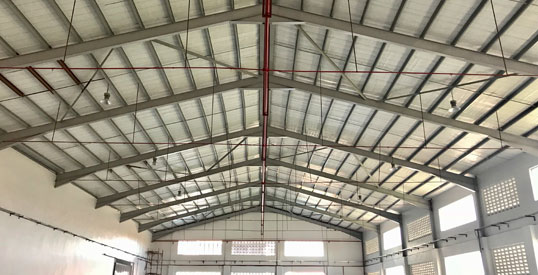FAQs

verb (used with object), prefabricated, prefabricating. to fabricate or construct beforehand. to manufacture in standardized parts or sections ready for quick assembly and erection, as buildings.
Prefabricated construction is the practice of assembling a variety of components of a steel structure at a manufacturing site and transporting those sub-assemblies to the location of the construction jobsite. Prefabricated construction is sometimes thought of as a low-end and mass-produced mode of construction.
Costs of Pre-engineered are typically cheaper than stick-built homes by an average of 10% to 20%. Faster Than Traditional Construction. Generally, it takes one to four months longer to build a traditional home than to construct a Pre-engineered. Flexible Size and Aesthetic.
Pre-engineered building materials are used for buildings that are manufactured off-site and shipped later to assemble at the final location same of the commonly used Pre-engineered building materials are aluminium steel, wood, fiberglass and concrete.
A warehouse is a building for storing goods. Warehouses are used by manufacturers, importers, exporters, wholesalers, transport businesses, customs, etc. They are usually large plain buildings in industrial parks on the outskirts of cities, towns, or villages.
A warehouse is a commercial building generally used for storage of goods and warehousing is the process of proper storage and handling of goods and cargo using scientific methods in the warehouse and making them available easily and smoothly when needed.
Different Types of Warehouses
- Distribution Centre. Distribution warehouses are used to store and sell large quantities of goods.
- Climate-controlled Warehouse. Climate-controlled warehouses are most often used to store and ship perishable goods
- Private Warehouse.
- Public Warehouse.
- Automated Warehouse.
- Fulfillment Centre.
A factory, manufacturing plant or a production plant is an industrial site, usually a complex consisting of several buildings filled with machinery, where workers manufacture items or operate machines which process each item into another.
This is the classification from the production process point of view, and the assembly type is the factory building where parts are assembled to make a product such as an automobile factory building, while a process-type factory building is where the product is produced from the material through a chemical change.
A factory building is an example of which factor of production? Physical capital. Human-made objects used to create other goods and services are physical capital.
Metal fabrication is the creation of metal structures by cutting, bending and assembling processes. It is a value-added process involving the creation of machines, parts, and structures from various raw materials.
Structural steel is usually fabricated to create structures like beams, trusses, hollow sections, angles and plates. These steel members must be accurately fabricated before assembling them together. All component parts of these members are fitted-up temporarily with rivets, bolts, or small amounts of welds.
Structural steel is a carbon steel, meaning it has a carbon content of up to 2.1 percent by weight. After iron, carbon is the most important element in carbon steel. Increasing the amount of carbon in the composition of steel results in materials that have high strength and low ductility.
Metal fabricators cut, shape, position and align different types of metal. They typically work for construction and manufacturing companies while the metals they work with are used to build structures.
Metalworking is the process of working with metals to create individual parts, assemblies, or large-scale structures. The term covers a wide range of metal work from large ships and bridges to precise engine parts and delicate jewellery.

Founder & CEO
Mukesh Patel is the Founder & CEO of Build Matt ltd, specializing in Pre-Engineered Buildings (PEB) and general steel fabrication. With advanced technology, modern machinery, and a skilled workforce, he delivers efficient and high-quality solutions across East and Central Africa, including Uganda, Kenya, Tanzania, Congo, South Sudan, Rwanda, and Burundi.
- CNC Plasma Cut Decorative Metal Panels: Revolutionizing Interior and Exterior Design
- Combining Roof Vents and Translucent Sheets for Better Airflow and Natural Lighting in Uganda Cities
- Top Design Trends in Steel Staircases for Modern Ugandan Buildings
- Steel Railings & Balustrades for Uganda Cities
- Modern Steel Silos & Hoppers : Transforming Grain Storage Efficiency in Uganda




